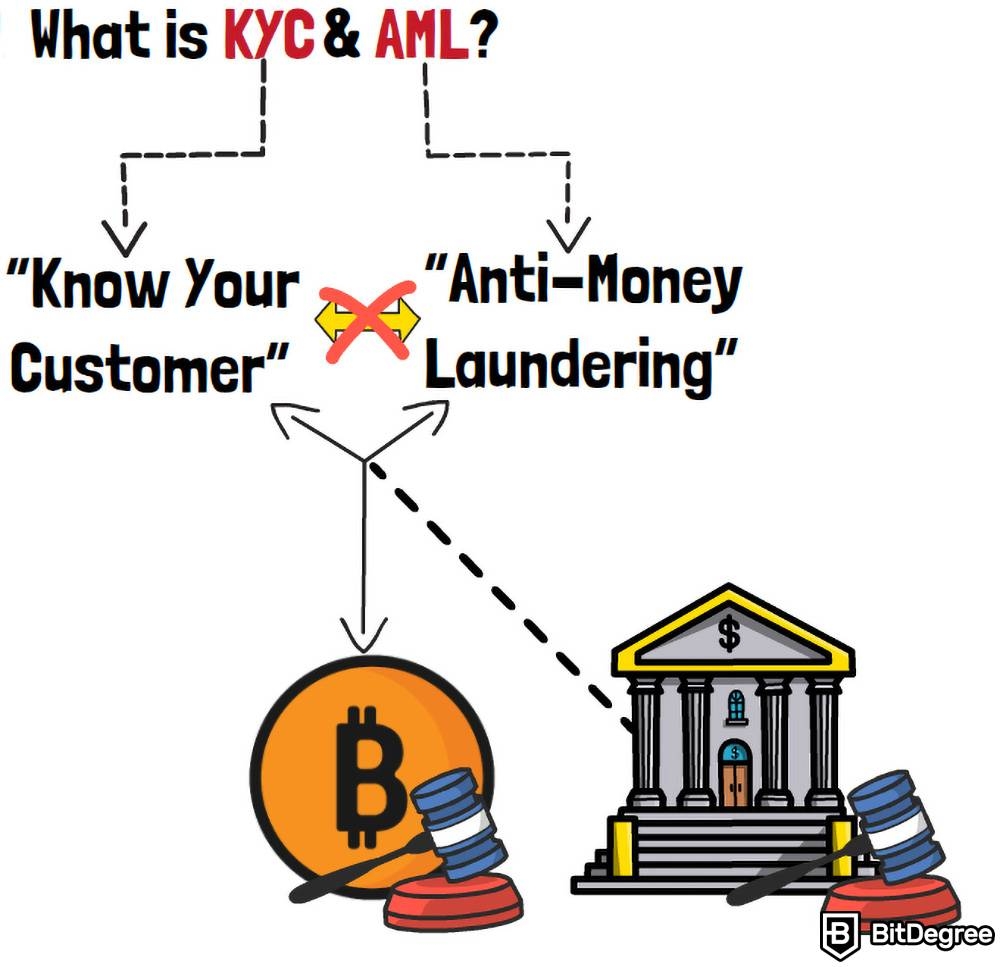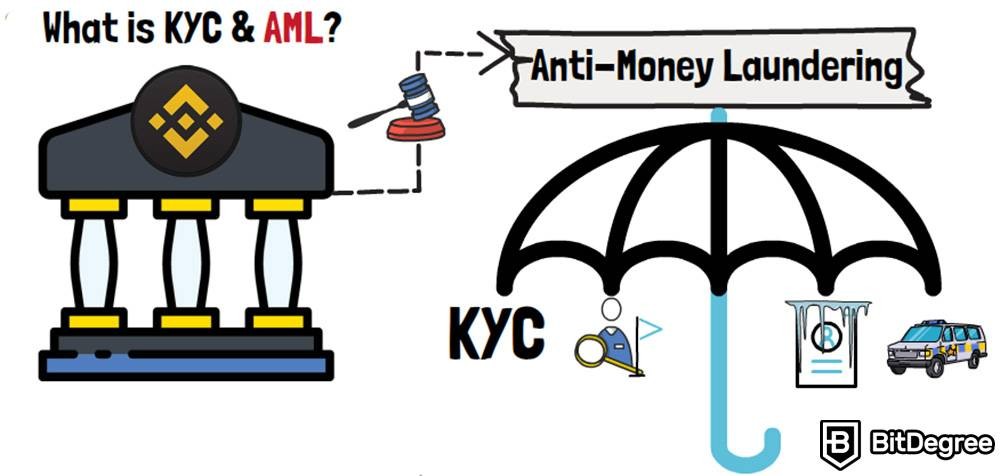KYC & AML: The Key to Complying With Legal Industry Standards
In this section, we’re going to talk about what is KYC in crypto!
Cryptocurrencies are a very exciting topic to explore - it seems like every day, there’s an innovative, industry-breaking concept being introduced with blockchain tech. To add to that, this industry is absolutely unpredictable - one day, you have meme tokens ruling the market, while the next, you have Elon Musk planning to put an actual, physical Dogecoin on the actual Moon!
There is, however, a less-exciting side to crypto, as well - one that has to do with regulations, investigations, and general bureaucratic processes. While it may not be as fun or cool as the aforementioned concepts, this side of crypto is still very important to understand, for any avid crypto enthusiast. And, this is where the concepts of AML & KYC crypto reside, as well.
So, in this section, we’re going to talk about AML & KYC in crypto. I will tell you what these terms mean, and explain them in the context of crypto. Then, we’ll also talk about the one, major controversy that surrounds them - make sure to stick around for this!
Now, then - let’s get to it!

Video Explainer
Video Explainer: KYC & AML: The Key to Complying With Legal Industry Standards
Reading is not your thing? Watch the "KYC & AML: The Key to Complying With Legal Industry Standards" video explainer
How Do KYC & AML Work in Crypto? (Explained)


What is KYC & AML?
So, to start things off, let’s first establish what does KYC mean in crypto, as well as where does AML come in, too.

Both of the terms in question are abbreviations - KYC stands for “Know Your Customer”, while AML is “Anti-Money Laundering”. As you might have guessed already, both concepts are also related to cryptocurrency regulation.
These terms are, admittedly, often used interchangeably. However, that’s not entirely the correct thing to do - you can think of AML crypto as a broad set of rules, one of which is KYC. There are other things that make up the Anti-Money Laundering concept, but, in this section, we’ll focus exclusively on KYC.
So, as far as the Know Your Customer regulations are concerned, the idea behind them is quite simple, really. If you’ve ever used a centralized cryptocurrency exchange, you probably know the drill - once you register on the exchange, and set up your profile, you still won’t be able to trade any cryptocurrencies until you’ve provided the exchange platform with some personal identification data of yourself.

That’s exactly what KYC is, from the user’s perspective - a form of identity verification, so that the exchange would know that it’s actually YOU who’s doing the trading and crypto acquisition. It usually includes a photo of your ID, a selfie, your residential address (and proof of residency, as well), information about your financial background, and so on.
Note that it’s possible to learn how to buy crypto without KYC, as well. This is usually done via decentralized exchange platforms, or non-KYC crypto exchanges. That said, these exchanges are usually quite complex - if you want to learn more, check out the section dedicated to this topic!
KYC & AML crypto compliance isn’t exclusive to cryptocurrency exchanges, however! All mainstream financial platforms must abide by strict Know Your Customer regulations, and identify their clients upon them registering on said platforms.
Here’s an example, to allow you to understand this easier: imagine that you decide to open up a new bank account, with a completely different bank from your current one. You go to the bank’s official website, fill out all of the boring paperwork, and set everything up. Now, part of your registration process will include KYC checks and verifications.
Why so? Well, there are a few big reasons. First, what if it’s not you who’s opening the bank account, but someone who’s impersonating you, with fake documents and IDs? In real life, this is quite simple to determine - if you’re opening a bank account online, though, it becomes much more difficult!
Secondly, what if you have a lot of debt, or are someone who possesses a really rough financial past? The banking institution needs to know about all of these things, so that they could then partake in complex risk management processes, and act accordingly.
Lastly, what if you’re an actual wanted criminal? Allowing a person like that to open a bank account, fill it with funds, and then perform transactions could mean terrible things! All of these things - and many more - make KYC a crucial element in having a safe financial system (as much as it is possible).
Everything that I’ve just mentioned applies to cryptocurrency exchanges and other crypto-related services, as well. However, with crypto still being a bit Wild West-ish, the mandatory KYC verification checks present on exchange platforms are often less intrusive than those that you’ll find with traditional financial institutions.
In regards to AML - or, Anti-Money Laundering - in crypto, you can view it as a sort of an umbrella term for all of the things that exchange platforms do, in order to comply with the legal industry standards and requirements. So, in this case, KYC is just a single element of AML - in addition to that, cryptocurrency exchanges are constantly surveilling their client activities, flagging questionable actions, freezing accounts, complying with the FBI and other law enforcement, and so on.

Feeling confused about what is KYC in crypto, as well as AML crypto compliance? Think of it this way - if KYC is an apple, then AML is an entire apple pie. Apples are a key part of the recipe, yes, but there are plenty of other ingredients that go into making that pie!
Both KYC & AML are quite difficult topics, and require a lot of crypto knowledge in order to be grasped, fully. If you’re looking to educate yourself more about all-things-crypto, check other sections on this Crypto 101 Handbook - there are chapters covering everything from the crypto basics, all the way to the more-advanced stuff!
The Big Controversy Surrounding Crypto KYC & AML
Now that you have a pretty good idea of what are KYC & AML, and how they work in the context of crypto, let’s move on to discussing “the big controversy” that these concepts find themselves in, within the cryptocurrency space.
Let me start off by asking you this - do you think KYC & AML are important and needed, when it comes to crypto? Now, while I can’t really hear your answer, I bet that everyone reading this section will have very different opinions on the topic.
In order to understand this fully, though, we must take a step back and look at the core values of cryptocurrency technology. Specifically, I’m talking about decentralization and anonymity - while you can check out a section on these two concepts, to put it short, they are at the very center of crypto tech, and are considered to be the key to crypto's success, in a very general sense.

Now, what’s the opposite of decentralization and anonymity? That’s right - identifying yourself to a centralized cryptocurrency exchange (or other services), and revealing personal information about yourself, your financials, and your life, in general.
You can probably see where I’m going with this.
Currently, there are two big groups of people in the crypto space - those who believe that crypto should remain completely decentralized and anonymity-preserving, and others who are a bit more liberal with their approach, and welcome KYC crypto and other regulations as a mandatory part of the “crypto going mainstream” process.
That’s kind of the kicker here, as well - it’s very easy to say that “crypto should remain decentralized and regulation-free!”, without evaluating what this means, on a bigger scale. Essentially, if you were to take KYC and AML out of crypto, completely, you would be eliminating centralized exchanges and other services, a huge array of major projects, as well as basically destroying the possibility for this asset class to become mainstream and massively adopted, for the foreseeable future.
Some people believe that this would essentially result in a cryptocurrency ice age. It’s a pretty bold statement, that’s true, but when you think about it, it makes sense - without any regulatory frameworks, crypto would be banned essentially everywhere, since no company or government would risk interacting with it, and being liable for any criminal activities that might be happening within the space.
The Future of KYC & AML in Crypto
Now, I admit - I really threw you into the deep end there! But, as complex as this topic might appear to be, it’s important to understand that things are NEVER black and white - KYC & AML crypto exchanges, as well as other services, aren’t an exception, either.

Every single day, the global crypto community is looking for viable compromises - ways of how to increase the mass adoption of crypto and blockchain technology, while still retaining as much of the earlier-mentioned traditional values as possible. It’s definitely not a simple problem to solve, and it also heavily depends on the region where you reside, as well! Some parts of the world are very open to crypto, while others aim to outright ban it.
These days, the general global focus appears to lie on increasing the reputability and security features of cryptocurrency service providers - centralized exchanges, lending and borrowing platforms, interest-earning projects, and so on. This is because even those crypto enthusiasts who agree that some form of KYC is mandatory for the space are skeptical about just how safe their personal information is with said platforms.
It makes sense, when you think about it! As I’ve mentioned previously, traditional financial institutions are regulated rather strictly. With crypto exchanges, for example, the regulations are usually a bit more “up in the air”, which makes some exchange platforms become too relaxed on their policies. Then, if some security vulnerability occurs on one of such exchanges, the information you’ve provided to the platform could be at risk of getting leaked and stolen!
Once again - these are very serious, as well as difficult problems to solve! However, they do impact the general ecosystem of the cryptocurrency market, and can really influence new technologies and the prices of your favorite crypto assets, too. If you are looking to become knowledgeable with crypto, KYC & AML issues are something that you really need to look into and understand!










